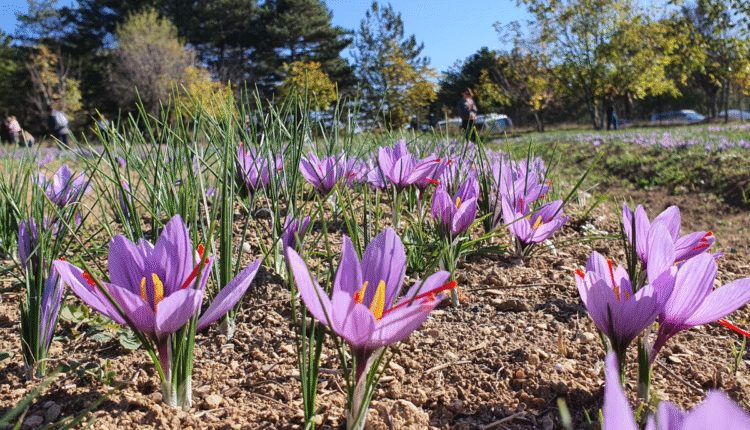Saffron Farming Information Guide | Kashmir is known for its immense beauty, but the world’s most precious and unique spice, which you know as saffron, is produced here. Saffron, which is called Saffron in English and Zafran in Urdu, is more expensive than gold.
Let us tell you that its flower, which is purple in color, blooms only for a short time, from inside which saffron is found in the form of threads. Saffron is used in excellent and delicious food as well as in many types of medicines. Saffron is also used in beauty products.
Which country produces the most saffron ?
Saffron, which is called the gold spice, is currently produced the most in Iran. Saffron is exported from here all over the world, but the saffron grown in Kashmir is unique. Its price is many times higher than the saffron sold in other countries.
Where is saffron cultivated in India?
The scientific name of saffron is Brokers Sector Wise, which is found from the flower of Crocus Sativus. In the country, the most saffron is cultivated in the Pampore area of Kashmir. After this, it is grown in Budgam and Srinagar. Saffron is grown in these special areas of Kashmir because saffron needs red soil to flourish.
Now saffron is also being cultivated in Harshil Valley of Uttarakhand and Bundelkhand of Uttar Pradesh. Saffron is also being grown in a closed room using scientific methods. At the same time, suitable places have been identified for saffron cultivation in northeastern states like Arunachal Pradesh, Meghalaya, Mizoram and Sikkim. Under the saffron cultivation project of NECTAR, a total of 64 farmers from Sikkim, Arunachal Pradesh and Meghalaya are taking advantage of this project.
Soil for saffron cultivation
Sandy and loamy soil is suitable for saffron cultivation. Saffron cannot grow in wet and water-filled places, due to which the saffron bromes start rotting. Saffron needs red soil to flourish.
When and how is saffron cultivated?
Saffron is the most expensive spice in the world, which is cultivated. It is unable to produce seeds through crossing, so saffron is prepared through bromes. After its germination, purple flowers emerge from its red and orange stigma. For its cultivation, saffron plants start being planted in the month of August. After this, flowers start blooming in the last week of October or in the month of November.
Temperature plays the most important role in the growth of saffron. It grows only in dry temperate weather at an altitude of 1500 to 2800 meters above sea level. A temperature of 23 to 27 degrees Celsius is important for the growth of chrome, otherwise the crop gets spoiled. On the other hand, a temperature of 07 degrees Celsius is right for the growth of purple flowers of saffron.
Time to plant saffron plants
The time to plant saffron plants is between September to October. According to the area, the plants are planted at an altitude of 1800 meters above sea level in high mountain areas and 1200 to 1800 meters in mid-mountain areas. In areas above 1800 meters, its seeds are sown in the second week of September, while in mid-mountain areas, its seeds are planted in the first week of October.
Saffron seeds
For saffron cultivation, about 40 to 50 quintals of saffron crocuses weighing an average of 10 grams are required for planting per hectare. One advantage of saffron cultivation is that its seeds do not have to be planted again and again. Once the seeds are planted, it keeps flowering for the next 15 years. When these seeds are taken out, they look exactly like garlic. It also has buds like garlic.
Irrigation for saffron cultivation
Saffron does not require much irrigation to grow. Saffron plants need irrigation in the last 15 days of September to October. Water is needed for the flowers to bloom quickly. Saffron does not require a lot of water. Overall, take care not to let the saffron plants dry in winter.
Weed Management for Saffron
The saffron crop takes a long time to mature, so it is also prone to serious diseases and infections caused by weeds. For this, the saffron field should be tilled in the first month of October. Weeds should be removed three to four times by hand, so that they can be controlled.
How is saffron prepared from flowers?
After the saffron plants flower, they are carefully picked one by one by hand. After this, the stamens, which look like threads inside the flowers, are removed from the flowers and after removing them, they are dried. These stamens turn into saffron, whose color is red or saffron. After picking the threads by hand, they are kept in the sun for drying for about a week. After this, it is kept in an airtight container for storage for at least 30 days. It is taken out for use only after this process.
Advanced varieties of saffron
There are three varieties of saffron in the world right now. These varieties are known by the names of Kashmiri saffron, American saffron and Iranian saffron.
Kashmiri Mongra saffron
Kashmiri Mongra is the most expensive saffron variety, its price is more than Rs 3 lakh per kg. It is found only in Kishtwar and Pampore areas of Jammu and Kashmir state of India. Plants of this variety are 20 to 25 cm high. Purple, blue and white flowers grow on saffron plants. Let us tell you that only 450 grams of saffron can be obtained from about 75 thousand flowers.
American variety of saffron
American variety of saffron is grown in Jammu and Kashmir as well as other areas. It does not require any special climate. This variety of saffron is also grown in Rajasthan. Its flowers are yellow.
Aquila saffron
The Aquila saffron variety is known as Iranian saffron. Iran fulfills 90% of the demand for saffron in the whole world, it is the largest producer of saffron. Aquila variety of saffron is also grown in Italy. In this variety, the colour of saffron is light but the quality is very good.
Identification of the quality of saffron
The quality of saffron depends on its colour (crocin) and taste (picrocrocin) along with its fragrance (safranal). The better the fragrance, the more bitter the taste.
Who can cultivate saffron?
Every citizen of India can cultivate saffron, he has got full legal rights, but, if we look at it generally, not all farmers are able to cultivate it, because saffron can be planted only in a few places in the country. The environment and soil required for its cultivation is found in only a few areas of Jammu and Kashmir. Farmers of other states or areas of India cannot cultivate it in their fields even if they want to. Due to low production, the price of saffron is more than diamond and gold.
Kashmiri saffron has got GI tag
Kashmir’s saffron has got Geographical Indication (GI). Being the most expensive spice, saffron is also called ‘red gold’.
Different names of saffron
The state of Jammu and Kashmir in India produces the most saffron. Saffron is also known by different names. In Hindi, saffron is called saffron, while in Urdu it is called Zafran, and in Kashmiri language it is called Kong. In Sanskrit it is known as Kunkuma and in Gujarat it is known as Keshar.
Saffron Park of Anantnag district
Saffron Park has been prepared for the farmers who produce the world’s most expensive spice i.e. Kashmiri saffron. This saffron park, which is a hub of organic saffron, is in Pampore area of Anantnag district of Jammu and Kashmir. The main objective of this saffron park is to increase the productivity of real saffron and to make its quality better. Here the saffron fields are spread far and wide, its beauty attracts the heart. All kinds of high-tech machinery related to saffron processing is also present here, which also does the work of packing and marketing.
How to identify Kashmiri saffron and Iranian saffron?
Only three threads come out of the purple coloured flower, which is saffron. Along with this, there are three yellow coloured threads in this flower, which are not saffron, they are called Patti. These yellow threads are used for other purposes. The biggest identity of Kashmiri saffron is that its back part is wide, while the saffron of Iran is thin from top to bottom. The saffron grown in Pampore, Kashmir is completely organic, but Iran’s saffron is produced by adding food, so it is chemical-laden.
Now saffron can be grown in a room of the house
Although Kashmir’s saffron which is of the best quality can be grown in only a few areas, but through scientific aeroponics technology, you can grow saffron in a room of your house. For this, the temperature of the room is controlled. In today’s time, many smart farmers are cultivating saffron in a room. Sandy, clayey or loamy soil is required to cultivate saffron in a room. For this, the temperature is controlled and the humidity is adjusted according to the cultivation of saffron. Aeroponics technology is quite famous in Iran, which is now slowly becoming popular in India as well.
History of Saffron
Harvard University Press, ‘Therapy with Saffron and the Goddess at Thera Book’, which contains historical documents, states that the Greeks were the first to grow saffron, after which saffron cultivation started on a commercial basis in many countries around the world. These include countries like India, Iran, Italy, France, Greece, Germany, China, Pakistan and Switzerland. Most saffron is produced in these countries today, but the quality of saffron produced in India is the best.
Countries producing saffron
Let us tell you that the global production of saffron is about 300 tons per year. In this, Iran, India, Spain and Greece are the most important saffron producing countries. Iran produces about 90 percent of the saffron production of the whole world. After this, India comes second, but India produces only 7 percent of the total production of the world. In our country, only Jammu and Kashmir is the state where the best quality saffron is produced. Let us tell you that saffron is cultivated only in a few places in Kashmir. One of them is Pampore.
Regarding the production of Kashmir in India, let us tell you that the total area of saffron cultivation is 3715 hectares, in which 3 to 4 kg per hectare. Here saffron is grown in [Pampore, Pulwama, Budgam, Srinagar, Kishtwar, out of which 86 percent of saffron is cultivated in 3200 hectares in Pampore alone. Even though about 300 tons of saffron of the total production is produced every year in some countries including Spain, Iran, but India’s saffron is the most beneficial and expensive.
Saffron market
According to Ayurvedic and Unani medicine, it keeps the mind cool, as well as eliminates physical weakness. If you consume saffron in some form daily, then it will keep you away from many diseases. The use of saffron improves eyesight, as well as many stomach related problems are also cured. Saffron is also very effective for depression patients. Saffron is also useful in treating arthritis patients.
Many top clothing fashion brands in the world use saffron to dye clothes because saffron leaves a lot of color. You can understand this from the fact that one gram of saffron can turn about 100 liters of water or milk saffron. Many cosmetic companies also use saffron in creams that enhance skin tone and facial glow.
Contact details: If farmers want to share information or experiences related to farming with us, then they can do this by calling us on the phone number 9599273766 or by writing an email to [email protected] or by sending your recording. Through Kisan of India, we will convey your message to the people, because we believe that if the farmers are advanced then the country is happy.



